Embrun New Build? Beat Frost Pockets This Fall Prep
Quick Summary: New homes in Embrun can have low spots called 'frost pockets' prone to early frost damage. Essential fall prep includes aeration, overseeding, fertilizing, proper mowing, leaf cleanup, and protecting new plants with mulch to ensure your yard thrives next spring.
- Identify and understand frost pockets in your new yard.
- Follow a fall lawn care checklist: Mowing, Aeration, Overseeding, Fertilizing, Watering, Leaf Management.
- Protect new trees, shrubs, and garden beds with mulch and wrapping if needed.
- Improve compacted new build soil with aeration and organic matter (compost).
Ready to ensure your new Embrun yard thrives this fall and beyond? Request a free quote today!
Introduction: Welcome to Embrun! Let's Talk Frosty Fall Surprises
Hey there, new Embrun neighbour! Huge congratulations on your new home – we're thrilled to welcome you to this fantastic community. Settling into a new place is always an adventure, isn't it? You've got the keys, maybe found most of the light switches, and now you're looking out at your very own patch of green. Ah, the joys of a new build yard – a blank canvas full of potential... and sometimes, a few frosty surprises, especially as autumn arrives here in the wider Ottawa region.
You might find that areas around Embrun, Russell, or even out towards Greely have unique little microclimates, particularly in newer developments. Ever heard of a "frost pocket"? It's not a fancy ice pack brand! It's often a low-lying spot in your yard, maybe where the *grading* isn't quite settled yet, that gets significantly colder than the surrounding area, especially overnight. This means an unexpected early *frost* can sneak in and nip your new *plants* when you least expect it.
Think of it as one of your home's first little quirks – charming, maybe, but potentially tough on your *gardening* efforts if you're caught unprepared. Understanding these cooler zones is key to smart *landscaping*. Don't fret! A little knowledge and some simple *fall prep* now can save you from disappointment next spring and get your yard thriving. Let's explore how to handle these chilly challenges!
Decoding Frost Pockets & Why Your New Embrun Lawn is Vulnerable
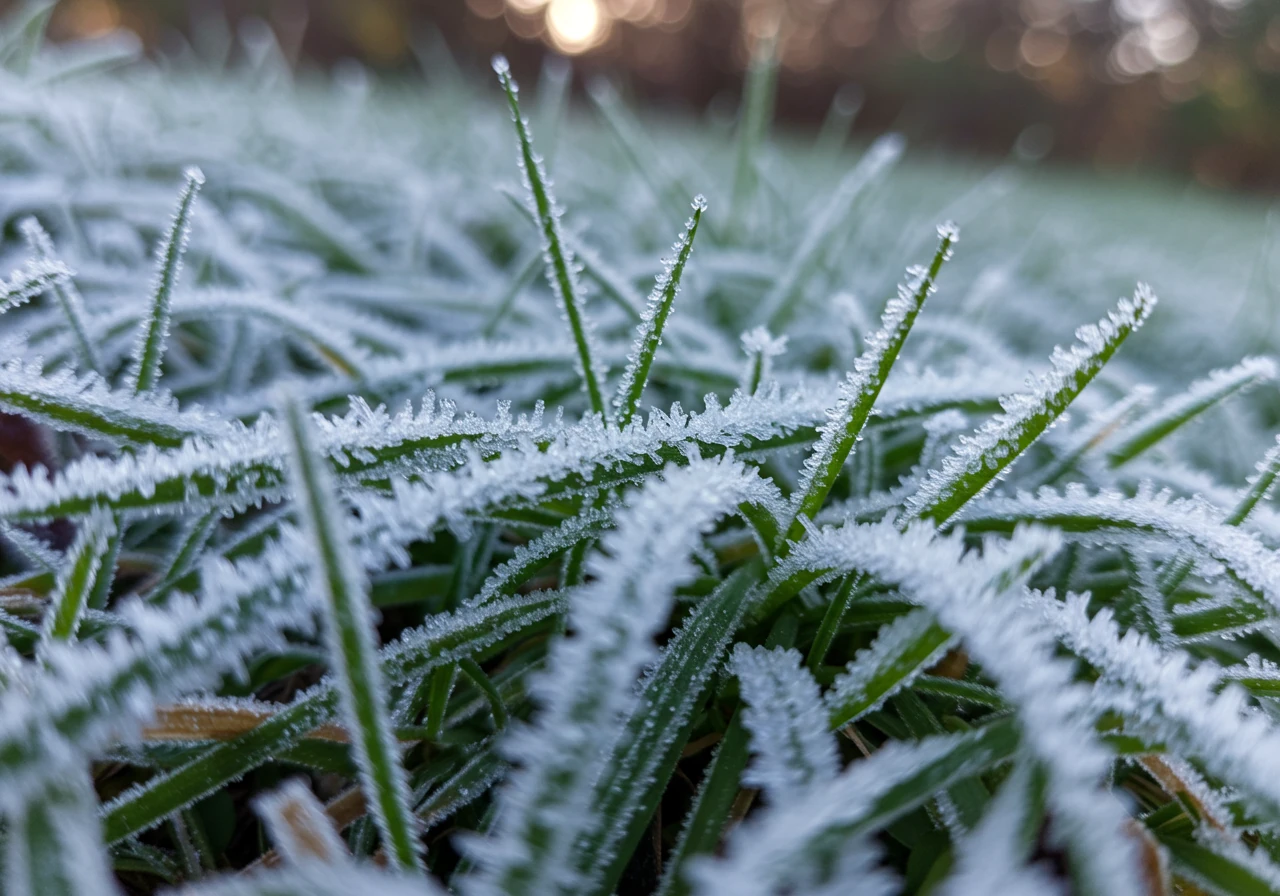
Alright, let's chat about those mysterious "frost pockets" we mentioned earlier. Sounds kind of cozy, like a warm spot for Jack Frost, right? Well, for your tender new lawn and *plants*, it’s actually the opposite! Think of a frost pocket as a mini-valley or dip in your yard where cold air likes to hang out.
Imagine cold air acting like water. On a clear, calm fall night here in the Ottawa region, the ground radiates heat away quickly. The air near the ground gets cold and dense. If your yard has low spots, maybe from recent *grading* or just the natural lay of the land, this heavy, cold air flows downhill and pools there, just like water settling in a puddle. Because this collected air is colder than the surrounding areas, frost forms *first* and *hardest* in these pockets, sometimes catching you (and your *gardening* plans) completely off guard, even when the weather forecast for Embrun seemed okay! For hyper-local conditions, check the Environment Canada Ottawa forecast.
So, why are new properties in areas like Embrun, or neighbouring communities such as Russell or even Greely, particularly prone to these chilly surprises?
- Freshly Graded Land: New construction often involves significant earth-moving. The final *grading* might look smooth, but subtle dips and depressions are common. It takes time for the landscape to truly settle. These low areas are prime real estate for cold air.
- Lack of Mature Landscaping: Established trees and shrubs act like blankets, trapping some warmth near the ground and blocking cold air movement. Your brand new yard likely doesn't have this mature vegetation yet, leaving it wide open.
- Disturbed & Compacted Soil: Construction traffic can compact the *soil* heavily. Compacted soil doesn't drain well (neither water nor cold air!) and can be slower to warm up. Improving this structure is crucial. Dealing with challenging conditions, like the common clay here, needs specific strategies; you can find helpful advice in our guide on Embrun Fall Plant Care & Clay Soil Solutions. Sometimes, improving drainage and soil structure through regular maintenance like lawn aeration is vital for soil health can make a big difference over time.
- Young, Vulnerable Grass: Your new lawn, whether seeded or sodded, is still establishing its root system. It's like a baby – more sensitive to stress, including sudden temperature drops. An unexpected hard frost in a pocket can damage or even kill off patches of this new *grass* before it’s strong enough to handle the cold. Building resilience often involves techniques like overseeding your Embrun lawn for thicker grass, which helps fill in weak spots.
What Can You Do About It?
Don't despair! Understanding is the first step. Observe your lawn on cool mornings – where does the frost linger longest? Those are likely your pockets.
- Protect Tender Plants: If you have specific vulnerable plants in a suspected frost pocket, cover them overnight with fabric, burlap, or even cardboard when frost is predicted. Remove covers in the morning!
- Improve Air Circulation: Sometimes, strategic planting or even temporary barriers can help redirect airflow, though this is more complex.
- Monitor Conditions: Keep an eye on local Embrun weather forecasts, especially overnight lows. For a high-tech approach, consider using tools for smart garden monitoring to prevent loss, which can give you precise temperature readings for specific spots in your yard.
- Focus on Lawn Health: A healthy, well-fed lawn with strong roots is better equipped to handle stress. Proper watering, fertilizing, and mowing are key components of lawn care.
- Fall Cleanup Matters: Removing thick layers of leaves, especially from low-lying areas, can sometimes help the ground absorb more daytime heat. If *fall prep* feels overwhelming, remember professional help is available. Check out our Embrun Yard Cleanup Service for a hand.
Understanding frost pockets helps you make smarter *landscaping* choices and protect your investment. While you can't change the weather rolling in from across the Ottawa valley, you can certainly give your new Embrun lawn the best possible start! If you need more comprehensive help with your lawn and garden challenges, explore the range of professional landscaping services we offer. Read about our approach on our About Us page or check our reviews on Google.
Fall Prep Timing Guide
Focus: Recovery & Seeding
This is the prime time for tasks that need recovery before winter.
- Core Aeration: Relieve summer compaction.
- Overseeding: Best window for seed germination.
- Early Leaf Cleanup: Prevent heavy buildup.
- Weed Control: Tackle perennial weeds before they go dormant.
Focus: Feeding & Protection
Prepare plants and lawn for colder weather.
- Fall Fertilization: Apply winterizer fertilizer.
- Continued Leaf Cleanup: Keep lawn clear as leaves fall heavily.
- Plant Perennials/Bulbs: Still time for planting spring bloomers.
- Cut Back Perennials (Optional): Tidy up beds.
Focus: Final Cleanup & Insulation
Last chance before the deep freeze or snow.
- Final Mowing: Cut grass to final height (2.5-3 inches).
- Thorough Leaf Removal: Critical final cleanup.
- Apply Mulch: Insulate plant roots after ground cools.
- Wrap Tender Plants/Trees: Protect from wind and sunscald.
- Clean & Store Tools: Prepare equipment for winter.
Your Essential Fall Lawn Prep Checklist: Building Resilience Before Winter Hits
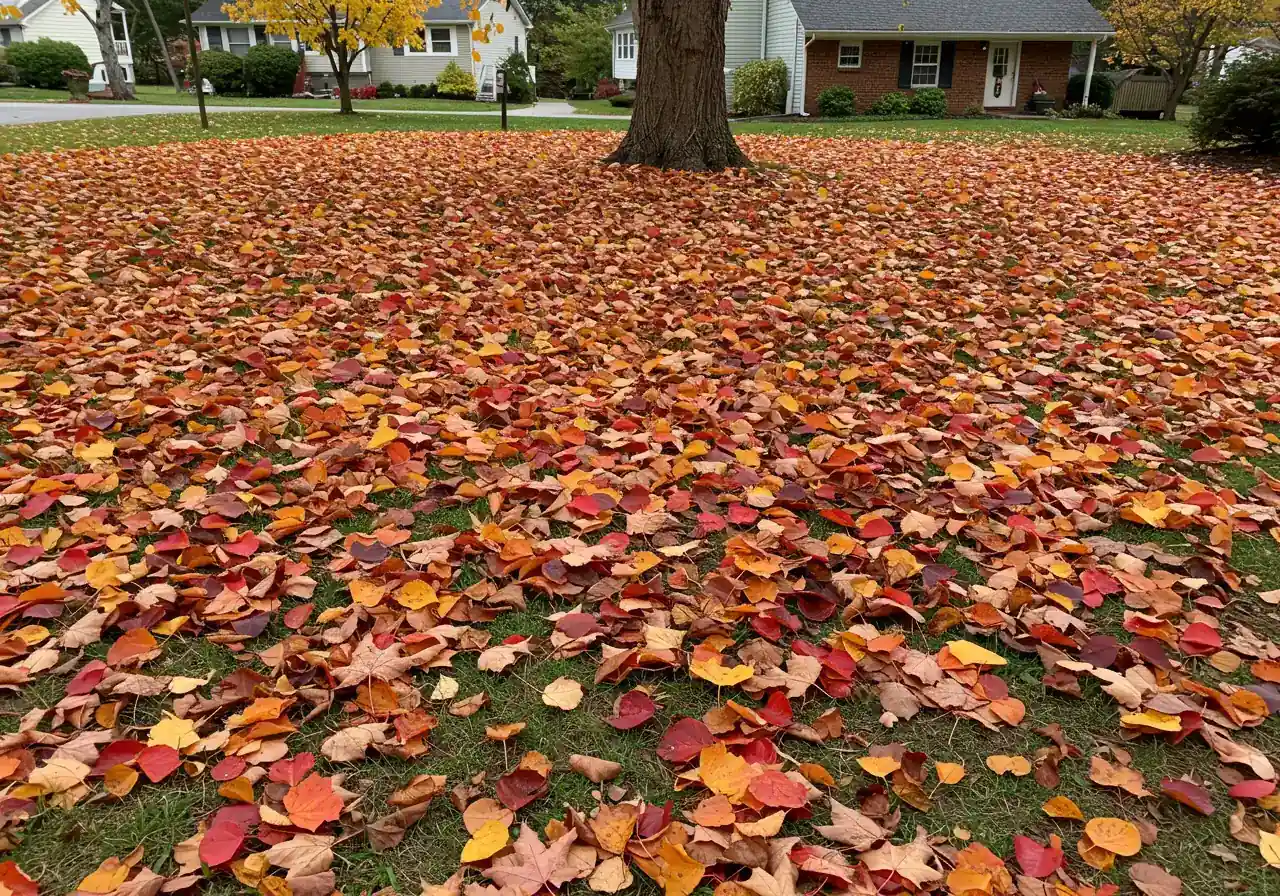
Alright neighbours, let's talk fall! While the changing leaves around Embrun are gorgeous, this season isn't just about pumpkin spice and cozy sweaters – it's crunch time for your lawn, especially if it’s a new one! Think of fall prep as sending your grass to a spa retreat before the tough Ottawa winter arrives. A little effort now means a happier, healthier lawn come springtime. Neglect it? Well, let's just say spring might bring more grumbles than green shoots.
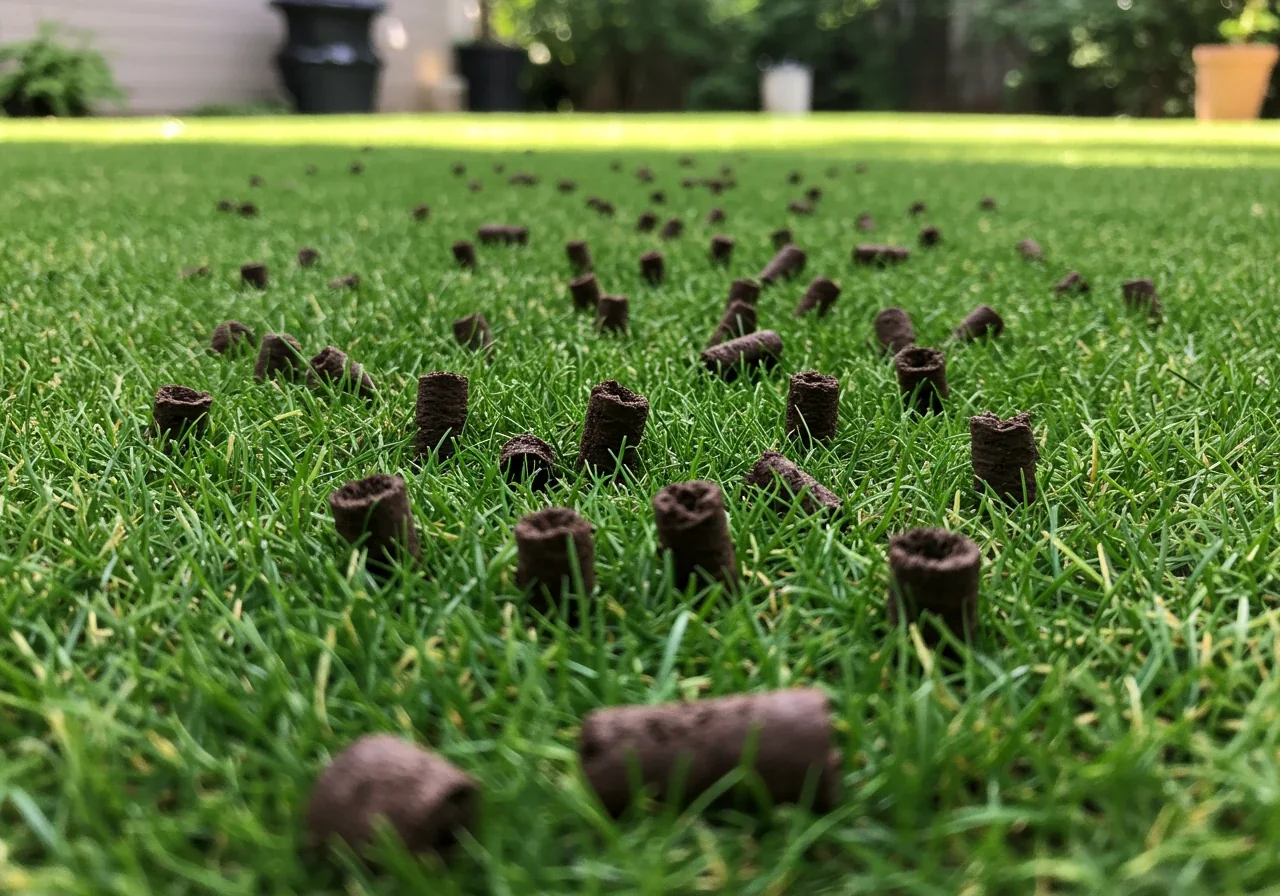
Here’s your essential checklist to build that resilience:
1. Keep Mowing (Don't Hang Up the Mower Just Yet!)
- Why: Surprise! Your grass keeps growing in the cool fall air, just slower. Letting it get too long invites snow mold and makes it look shaggy. Cutting it *too* short (scalping) stresses it out right before winter.
- How: Keep mowing as needed. For the last 2-3 cuts of the season, gradually lower your mower blade height. Aim for a final height of about 2.5 to 3 inches. This helps prevent matting under snow while leaving enough blade surface to soak up some winter sun.
- Timing: Continue until growth noticeably stops, usually late October or even early November around here.
2. Aeration Station (Especially Crucial for New Builds!)
- Why: Remember how we talked about compacted soil in new developments? Construction traffic can turn your yard's soil into something resembling a brick. Aeration is key! It involves pulling small plugs of soil out of the lawn. This lets vital air, water, and nutrients penetrate deep down to the roots, relieving compaction and improving drainage. It's a fundamental step in good soil preparation for a healthy lawn.
- How: Rent a core aerator (the kind that pulls out plugs, not just pokes holes) or hire a pro. Go over your entire lawn once or twice. Leave the soil plugs on the lawn – they’ll break down naturally, adding organic matter back into the soil.
- Timing: Early fall (September to early October) is prime time. The ground is usually moist enough for the machine to work effectively, but not soaking wet.
3. Overseed for Thickness (Fill in the Gaps!)
- Why: New lawns often have thin patches. Overseeding involves spreading grass seed over your existing lawn. It helps thicken the turf, introduces resilient grass varieties suited for our climate, and makes it harder for weeds to take hold next spring.
- How: Choose a quality grass seed mix recommended for the Ottawa region. Spread it evenly using a broadcast or drop spreader, following the recommended rate on the package. Rake it in *lightly* to ensure good seed-to-soil contact, especially after aerating.
- Timing: Immediately after aeration in early to mid-fall (September/October). This gives the seeds time to germinate and establish a bit before the harsh cold sets in.
4. Fall Feast (Time to Fertilize!)
- Why: Think of this as packing a lunchbox for your lawn's winter sleep. A fall fertilizer, typically higher in potassium, promotes strong root growth through the fall and even under snow cover. This leads to a quicker green-up next spring and better overall resilience.
- How: Apply a slow-release granular fertilizer specifically formulated for fall application. Use a spreader for even coverage, following the product instructions carefully. Too much can harm your lawn!
- Timing: Mid- to late fall (late September through October), ideally a few weeks after overseeding when the new grass has started to grow, but before the ground freezes solid.
5. Water Wisely (But Don't Stop Too Soon!)
- Why: New grass seed needs consistent moisture to sprout. Even established lawns need water during dry fall spells to stay healthy and absorb that fertilizer. Keeping the soil reasonably hydrated before the deep freeze can also offer some insulation to the roots.
- How: Water newly seeded areas lightly and frequently until germination. For the established lawn, water deeply (about 1 inch per week, including rainfall) if things get dry. Taper off as the weather gets consistently cold and the ground begins to freeze.
- Timing: As needed through September and October. Stop regular watering once the ground starts freezing.
6. Leaf Management Mania (Rake It or Mulch It!)
- Why: A thick blanket of fallen leaves looks poetic, but it smothers your grass, blocking sunlight and air, inviting diseases like snow mold, and creating cozy homes for pests. Seriously, get those leaves up! For local guidance, the City of Ottawa's gardening pages often have seasonal tips.
- How: Rake them regularly! Or, if you have a mulching mower and the leaf layer isn't too thick, you can mow over them a few times to shred them into tiny pieces that decompose and feed the soil. If the leaf volume feels overwhelming (we get it!), professional help is a great option. Services like an Embrun Yard Cleanup Service or similar providers in nearby areas like a Metcalf Garden Clean Up Service or even a Marionville Yard Cleanup Service can take this chore off your hands. Keeping things tidy is a key part of year-round garden maintenance. We also serve the broader area, including City Yard Cleanup Service.
- Timing: Continuously as leaves fall. Aim for a final, thorough cleanup just before the first permanent snowfall is expected.
Following these steps sets your lawn up for success, making it stronger and more prepared to face the winter. Plus, a healthy lawn this fall is the perfect foundation if you're dreaming about future projects like a beautiful garden install next spring!
Common Fall Lawn Issues in New Builds
Typical Problems (%) Addressed by Fall Prep
Beyond the Grass: Protecting Your New Trees, Shrubs & Garden Beds
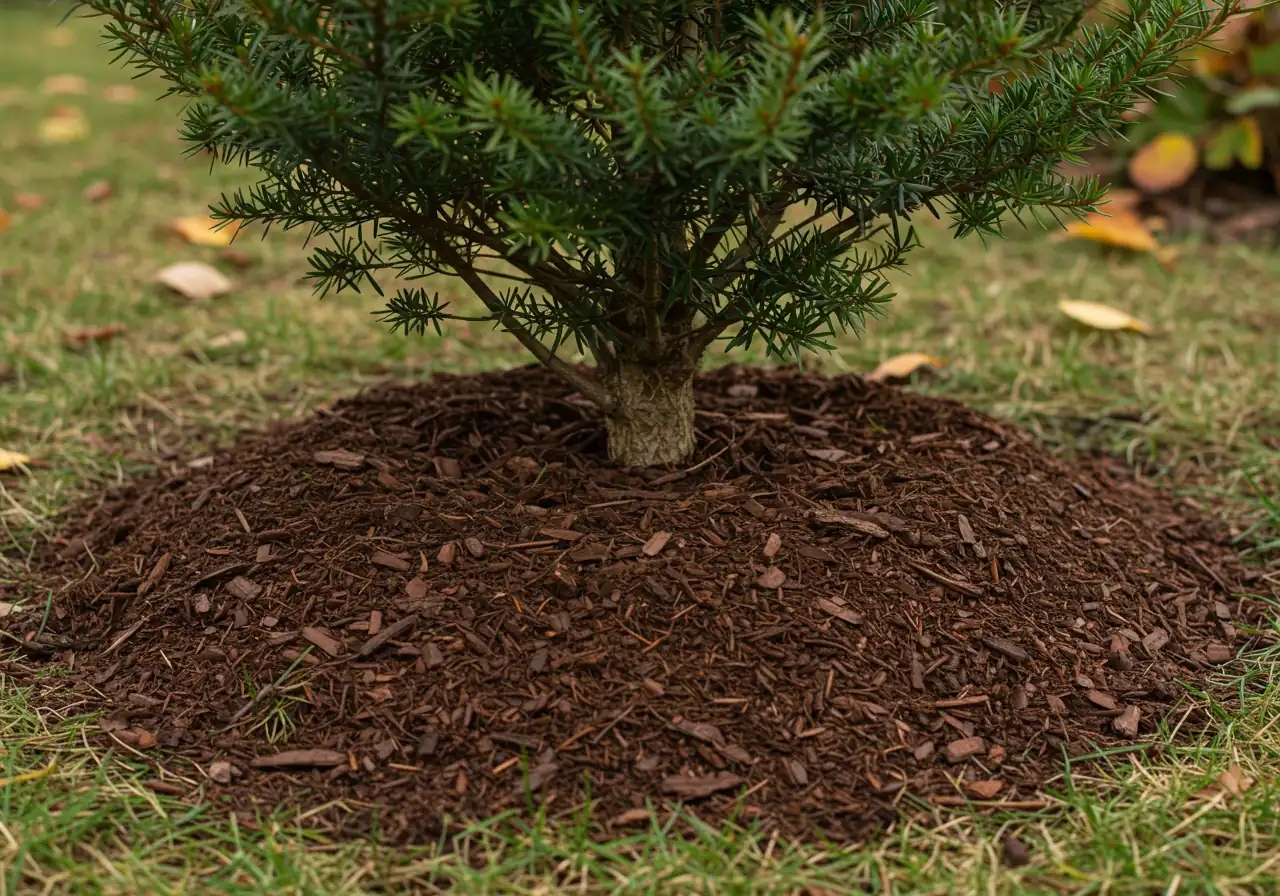
Okay, so we've given your new lawn a pep talk and a winter survival kit. But what about the other new arrivals in your yard? Those lovely trees, hopeful shrubs, and brand-new garden beds need some TLC too, maybe even more so than the grass as they face their first chilly Ottawa winter. Think of them as the slightly nervous freshmen at winter orientation – they need a little extra guidance!
New plantings haven't had a full season (or years!) to establish deep, robust root systems. They're more susceptible to the stresses of freezing temperatures, drying winter winds, and those annoying freeze-thaw cycles that can heave them right out of the ground. Don't worry, though – a bit of preparation goes a long way!
Mulch is Your Friend (Like, Your *Best* Friend)
- Why: Mulch acts like a cozy winter blanket for the soil around your new plants. It helps insulate the roots from extreme cold, prevents moisture loss, and stops the ground from repeatedly freezing and thawing, which can damage tender roots.
- How: After the ground has cooled down but *before* it freezes solid (usually late October/early November), apply a layer of organic mulch (like shredded bark, wood chips, or even shredded leaves) around the base of your new trees and shrubs. Aim for a layer about 2-4 inches thick. Crucially, *do not* pile mulch right up against the trunk or stems – leave a few inches of space around the base to prevent rot and discourage pests. Proper material selection is key; different mulches offer varying benefits. Spread mulch evenly over your perennial garden beds too, after you’ve done some cleanup.
- Cleanup First: Speaking of cleanup, ensuring beds are tidy before mulching helps prevent diseases. If fall tidying feels overwhelming, remember services like an Ottawa Garden Clean Up Service can handle removing dead annuals and cutting back perennials. We also offer City Garden Clean Up Service and options for nearby communities like Marionville Garden Clean Up Service.
Wrap 'Em Up (Sometimes!)
- Why: Some plants need extra protection from harsh winter winds (which cause drying, called 'desiccation') or sunscald (winter sun reflecting off snow can burn bark/needles). Young trees with thin bark and certain evergreens (especially cedars and broadleaf evergreens like rhododendrons) are prime candidates. Also, if you live near green spaces, perhaps in areas like Kars, Osgoode, or Richmond, wrapping can deter hungry deer and rabbits looking for a winter snack. For advice on region-specific plant hardiness, consult resources like the Master Gardeners of Ottawa-Carleton.
- How: Use burlap, breathable landscape fabric, or specialized tree guards. For shrubs, you can create a burlap screen on the windward side or loosely wrap the entire plant, ensuring air can still circulate. Secure it with twine, but not too tightly. For tree trunks, use plastic or mesh tree guards around the base to prevent rodent gnawing and bark splitting. Remove wraps promptly in spring as temperatures warm up.
- Who Needs It Most: Young deciduous trees (wrap trunks), upright evergreens (wrap foliage or use screens), newly planted roses, and anything known to be borderline hardy in our Zone 5 climate.
Perennial Prep
- Tidy Up (Mostly): Cut back most dead perennial stalks to about 4-6 inches. This looks tidier and removes potential homes for pests or disease. However, consider leaving sturdy stems on plants like Coneflowers or Sedum 'Autumn Joy' – they provide winter interest and food/shelter for birds.
- Mulch Matters: Apply that layer of mulch after cleanup and once the ground is cool.
- Mark Your Territory: If you planted tiny new perennials, pop in a plant marker so you remember where they are next spring!
Taking these steps helps ensure your investment in new trees, shrubs, and perennials pays off with healthy growth next spring. Completing a thorough fall cleanup around these protected plants is also beneficial. If you're managing a larger property, consider a comprehensive Ottawa Property Cleanup Service to get everything ship-shape. Even smaller regional areas have options, like a Marionville Yard Cleanup Service if that's closer to home. An overall Ottawa Yard Cleanup Service can tackle leaves, debris, and final mowing, letting you focus on protecting your precious plantings. And remember, when engaging any service provider, it's good practice to understand their scope of work, often outlined in their company Terms and Conditions. Give your new plants this extra bit of care, and they'll reward you handsomely when the growing season returns!
New Build Yard: First Year Milestones Timeline
Spring (Year 1)
Assess final grading, check drainage post-snowmelt. Plan lawn/garden areas. Initial soil testing if concerned.
Summer (Year 1)
Establish lawn (sod/seed). Focus on consistent watering. Begin basic garden maintenance. Monitor for construction debris.
Fall (Year 1 - Crucial Prep!)
Perform checklist: Aerate, overseed weak spots, fertilize, manage leaves. Mulch new plants. Protect vulnerables.
Winter (Year 1)
Lawn & most plants are dormant. Avoid heavy foot traffic on frozen lawn. Monitor protective wraps.
Spring (Year 2)
Evaluate winter survival. Rake lightly. Apply spring fertilizer. Address any damage. Plan ongoing lawn care schedule.
Tackling New Build Soil Woes: Improving Drainage to Minimize Frost Damage
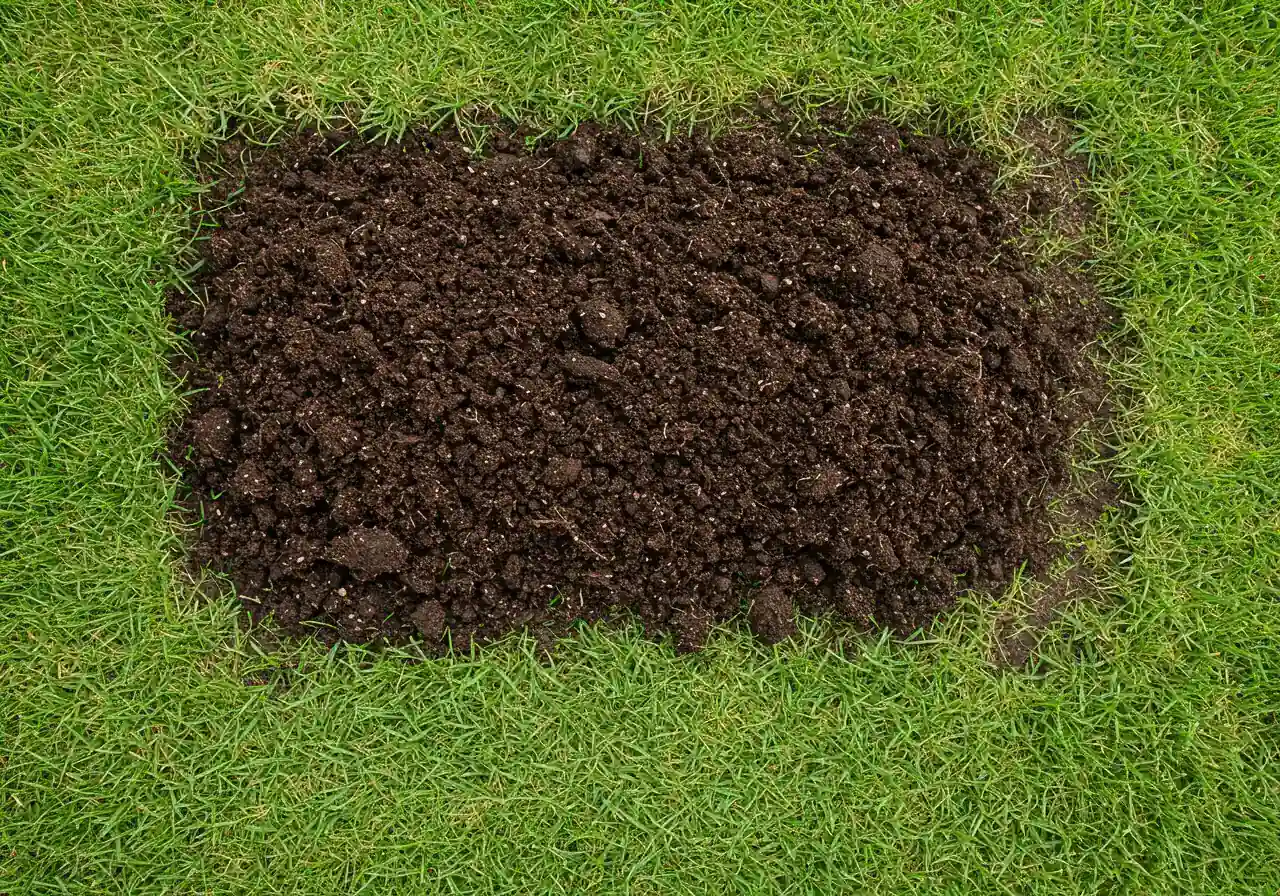
So, you’ve got this brand-new yard in Embrun, maybe out near Barrhaven or Nepean, and... does the ground feel suspiciously like a parking lot sometimes? Yeah, new build *soil* can be a bit of a challenge. Often, the good topsoil gets scraped away during construction, and heavy machinery compacts what's left into dense, stubborn clay or subsoil. It’s like getting a *garden* plot made of bricks – not exactly welcoming for tender plant roots!
This compaction is Public Enemy No. 1 when it comes to *drainage*. Water just sits there, creating puddles after rain or snowmelt. And guess what loves soggy, slow-draining soil in the fall and winter? *Frost*! Poorly draining soil stays wet, and wet soil freezes solid much faster and harder than well-drained soil. This deep, hard frost is exactly what makes those pesky *frost pockets* worse, potentially heaving new *plants* right out of the ground or damaging their roots.
But don't throw in the trowel just yet! Improving your soil's *drainage* is totally doable and makes a HUGE difference.
- Bring on the Air! (Aeration Power): We mentioned *core aeration* for lawn health before, but it's also a superhero for drainage. Punching those holes breaks up compaction, creating channels for water (and air!) to move through the soil profile instead of just sitting on top. Think of it as giving your soil pores to breathe and drain.
- Feed the Soil (Organic Matter Magic): After aerating is the perfect time to introduce the good stuff: *organic matter*. Spreading a layer of quality compost over your lawn and garden beds (called 'topdressing') works wonders. Organic matter acts like a sponge in sandy soil (helping it hold *some* moisture) but breaks up and lightens heavy clay soil, drastically improving its structure and *drainage*. This soil amendment is a key part of long-term *gardening* success and overall property clean up and enhancement. While you might handle small areas yourself, larger topdressing jobs can be part of a bigger yard project, perhaps following work by an Ottawa Property Cleanup Service to clear the way first. Consider also services for areas like Metcalf Yard Cleanup Service.
- Mind the Low Spots (Minor Grading): Take a look after a heavy rain. See any mini-ponds forming? These subtle low spots might need a little attention. For *minor* dips contributing to frost pockets, sometimes gradually adding small amounts of good quality topsoil mixed with compost over time can help level things out. Major *grading* issues, however, usually need professional assessment.
Improving your soil isn't just about preventing frost damage; it's eco-friendly *landscaping*! Healthy, well-draining soil needs less watering, reduces runoff, and supports a thriving ecosystem of beneficial microbes and earthworms. Whether you're in the city core needing a city property cleanup service or further out requiring something like a Metcalf Property Cleanup Service, tackling soil health is fundamental. If you have questions about soil amendment or need help, feel free to reach out – we respect your data as outlined in our privacy policy, and we'll send you a quick thank you message for connecting! Building better soil now means fewer headaches and a healthier, happier yard for years to come.
Frost Pocket Fighters - Your Quick Fall Checklist
Feeling the chill? Don't let those sneaky frost pockets ambush your beautiful new Embrun yard! Here’s a rapid-fire checklist to help your landscape stand strong against the cold snaps common across the Ottawa region, whether you're lakeside in Manotick or in a brand new development.
- Aerate & Amend Your Soil: Punch holes in that compacted ground (especially important for new builds!) to improve drainage and let roots breathe. Follow up by topdressing with compost to enrich the soil. Good drainage is your first line of defense against damaging frost heave. Remember, healthy soil is the foundation of good lawn care.
- Mulch Like You Mean It: Tuck your trees, shrubs, and perennials in for the winter! Apply a 2-4 inch layer of organic mulch *after* the ground cools but *before* it freezes solid. Keep mulch away from direct contact with stems and trunks. This insulation helps moderate soil temperature. Need tips on the best mulch or help with application? Check out our info on mulching and edging.
- Wrap or Cover Tender Plants: Give vulnerable newbies – like young trees with thin bark, certain evergreens, or borderline hardy shrubs – some extra winter armour. Use burlap, tree wrap, or screens to protect against harsh wind, sunscald, and maybe even nibbling critters. Remove wraps promptly in spring!
- Keep Leaves Clear: Don't let thick leaf blankets smother your grass or garden beds. Rake regularly or use a mulching mower if the layer isn't too heavy. Letting leaves pile up invites disease and pests. If the leaf tsunami gets overwhelming, a professional hand like a city garden clean up service can save your back and your weekend.
- Fertilize for Winter Strength: Apply a fall-specific fertilizer before the ground freezes. This feeds the roots, promoting strength and resilience for a quicker green-up next spring. It's a key part of proactive city garden maintenance service.
Tackling these steps can make a huge difference! If you have questions about tailoring this advice to your specific yard, feel free to reach out – we respect your information, as detailed in our privacy policy. Happy frost fighting!
Embrun & Ottawa Fall Prep FAQs: Your Questions Answered
Great question! Seeding *can* work in early fall (September/early October) here in the Ottawa region, giving roots time to establish before the deep freeze. However, seeding later than mid-October gets risky with frost. If you've missed that window, focusing on soil prep now and considering spring seeding or professional sod installation might be less stressful options for a lush lawn next year.
Oh yes, aeration is *definitely* worth it, especially on compacted new build soil! Clay gets squished easily. Core aeration pulls out plugs, creating channels for air, water, and nutrients to get down to the roots. It’s a crucial step in improving drainage and soil structure over time. You might be surprised by the long-term improvements – check out some inspiring lawn transformations to see the difference good practices make!
Hey, it happens! If you do only one thing, make it leaf cleanup. Letting thick layers of wet leaves sit on your lawn all winter is an open invitation to snow mold and pests. Rake them up or mulch them with your mower if it's just a light layer. Getting debris cleared is key. If you're overwhelmed, look into local help like a Marionville property cleanup service or similar providers for a final tidy-up.
Don't panic just yet! Minor tip browning from frost isn't usually fatal, especially on evergreens like cedars. Ensure they have a good layer of mulch (not touching the trunk!) to protect the roots. If you're concerned about windburn or further cold, you could loosely wrap them in burlap. If you see widespread browning or aren't sure, feel free to contact us – sometimes a quick look can diagnose the issue.
Cleanup costs depend on factors like yard size, the amount of leaves/debris, accessibility, and specific tasks included (e.g., final mow, garden bed cleanup). Getting a couple of quotes can give you a baseline. Reputable companies should clearly outline what's included. Don't hesitate to ask questions! If you've received an estimate from us and want to discuss it, we welcome your estimate feedback to ensure everything is clear.
Conclusion: Set Your Embrun Lawn Up for Spring Success!
Whew! Moving into a new home is a whirlwind, isn't it? Now that you're settling into lovely Embrun, let's make sure your new yard gets the best possible start for a glorious spring. We've chatted about those surprise *frost pockets* and the often-compacted *soil* that comes with new builds here in the wider Ottawa region. Remember, tackling *fall prep* now isn't just about tidying up – it's a crucial investment in your *lawn's* future health.
Think of *aeration* as giving your soil room to breathe and *drain* properly. Smart *mulching* is like tucking your new *plants* and shrubs into a cozy winter blanket. And diligent leaf *cleanup* prevents nasty surprises like snow mold. These steps work together to fight *frost* damage, improve your *soil*, and build resilience against our chilly winters. A little effort this autumn truly sets the stage for easier *gardening* and a faster, greener, healthier lawn next spring – meaning less stress and more enjoyment for you!
Don't let fall overwhelm you! If you'd rather spend your weekends exploring Embrun, Russell, or maybe grabbing a coffee in nearby Metcalfe or Winchester, let us handle the heavy lifting. From comprehensive *Fall Cleanup* services like our Metcalf Property Cleanup Service to essential *Lawn Aeration*, Clean Yards is ready to help get your new property ready to thrive. Give your lawn the head start it deserves! Visit CleanYards.ca or contact us today for a personalized quote and set your *Embrun lawn up for spring success*!

